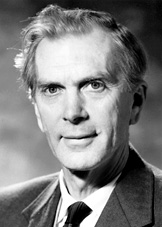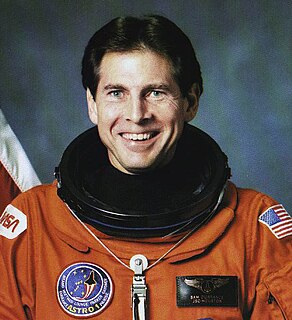
Sir Martin Ryle was an English radio astronomer who developed revolutionary radio telescope systems and used them for accurate location and imaging of weak radio sources. In 1946 Ryle and Derek Vonberg were the first people to publish interferometric astronomical measurements at radio wavelengths. With improved equipment, Ryle observed the most distant known galaxies in the universe at that time. He was the first Professor of Radio Astronomy at the University of Cambridge, and founding director of the Mullard Radio Astronomy Observatory. He was Astronomer Royal from 1972 to 1982. Ryle and Antony Hewish shared the Nobel Prize for Physics in 1974, the first Nobel prize awarded in recognition of astronomical research. In the 1970s, Ryle turned the greater part of his attention from astronomy to social and political issues which he considered to be more urgent.

Samuel Thornton Durrance (Ph.D.) is an American scientist who flew aboard two NASA Space Shuttle missions as a payload specialist.

Donald Lynden-Bell CBE FRS was a British theoretical astrophysicist. He was the first to determine that galaxies contain supermassive black holes at their centres, and that such black holes power quasars. Lynden-Bell was President of the Royal Astronomical Society (1985–87) and received numerous awards for his work, including the inaugural Kavli Prize for Astrophysics. He worked at the University of Cambridge for his entire career, where he was the first director of its Institute of Astronomy.

The Institute of Astronomy (IoA) is the largest of the three astronomy departments in the University of Cambridge, and one of the largest astronomy sites in the UK. Around 180 academics, postdocs, visitors and assistant staff work at the department.

Richard Salisbury Ellis CBE FRS is Professor of Astrophysics at the University College London. He previously served as the Steele Professor of Astronomy at the California Institute of Technology (Caltech). He was awarded the 2011 Gold Medal of the Royal Astronomical Society.

James Edward Gunn is the Eugene Higgins Professor of Astronomy at Princeton University. Gunn's early theoretical work in astronomy has helped establish the current understanding of how galaxies form, and the properties of the space between galaxies. He also suggested important observational tests to confirm the presence of dark matter in galaxies, and predicted the existence of a Gunn–Peterson trough in the spectra of distant quasars.
Robert Charles Kennicutt, Jr. FRS is an American astronomer. He is the Plumian Professor of Astronomy at the Institute of Astronomy in the University of Cambridge. He was formerly Editor-in-Chief of the Astrophysical Journal (1999–2006). His research interests include the structure and evolution of galaxies and star formation in galaxies.

Kenneth Charles Freeman is an Australian astronomer and astrophysicist who is currently Duffield Professor of Astronomy in the Research School of Astronomy and Astrophysics at the Mount Stromlo Observatory of the Australian National University in Canberra. He was born in Perth, Australia in 1940, studied mathematics and physics at the University of Western Australia, and graduated with first class honours in applied mathematics in 1962. He then went to Cambridge University for postgraduate work in theoretical astrophysics with Leon Mestel and Donald Lynden-Bell, and completed his doctorate in 1965. Following a postdoctoral appointment at the University of Texas with Gérard de Vaucouleurs, and a research fellowship at Trinity College, Cambridge, he returned to Australia in 1967 as a Queen Elizabeth Fellow at Mount Stromlo. Apart from a year in the Kapteyn Institute in Groningen in 1976 and some occasional absences overseas, he has been at Mount Stromlo ever since.

Claire Ellen Max is a Professor of Astronomy and Astrophysics at the University of California, Santa Cruz and is affiliated with the Lick Observatory. She is the Director of the Center for Adaptive Optics at UCSC. In 1972 she received her Ph.D. in Astrophysical Sciences from Princeton University, following her B.A. degree in Astronomy from Harvard University, in 1968.

Somak Raychaudhury is an Indian astrophysicist. He is the Director of the Inter-University Centre for Astronomy and Astrophysics (IUCAA), Pune. He is on leave from Presidency University, Kolkata, India, where he is a Professor of Physics, and is also affiliated to the University of Birmingham, United Kingdom. He is known for his work on stellar mass black holes and supermassive black holes. His significant contributions include those in the fields of gravitational lensing, galaxy dynamics and large-scale motions in the Universe, including the Great Attractor.

Reinhard Genzel is a German astrophysicist.

Simon David Manton White, FRS, is a British astrophysicist. He is one of four directors at the Max Planck Institute for Astrophysics.
Govind Swarup is a radio astronomer and one of the pioneers of radio astronomy. He is known not only for his many important research contributions in several areas of astronomy and astrophysics, but also for his outstanding achievements in building ingenious, innovative and powerful observational facilities for front-line research in radio astronomy. He has been the key scientist behind concept, design and installation of the Ooty Radio Telescope (India) and the Giant Metrewave Radio Telescope (GMRT) near Pune. Under his leadership, a strong group in radio astrophysics has been built at Tata Institute of Fundamental Research that is comparable to the best in the world.

Roger Llewelyn Davies is a British astronomer and cosmologist, one of the so-called Seven Samurai collaboration who discovered an apparent concentration of mass in the Universe called the Great Attractor. He is the Philip Wetton Professor of Astrophysics at Oxford University. His research interests centre on cosmology and how galaxies form and evolve. He has a longstanding interest in astronomical instruments and telescopes and developed the scientific case for the UK's involvement in the 8m Gemini telescopes project. He has pioneered the use of a new class of astronomical spectrograph to measure the masses and ages of galaxies, as well as search for black holes in their nuclei. He is the founding Director of the Oxford Centre for Astrophysical Surveys which is funded by the Hintze Family Charitable Foundation.
Lennox Lauchlan Cowie FRS is a Scottish astronomer, and professor at the Institute for Astronomy, University of Hawaii.

René Racine is a Québécois Canadian professor and astronomer who specializes in the study of globular clusters. He has also achieved international renown for his work with galaxies, astronomical instruments and adaptive optics.
George Kildare Miley is an Irish-Dutch astronomer. He holds a professorship at Leiden University, where he served as director of Leiden Observatory from 1996 to 2003.

Dr. Martin C. Weisskopf is project scientist for NASA's Chandra X-ray Observatory and Chief Scientist for X-ray Astronomy in the Space Sciences Department at NASA's Marshall Space Flight Center in Huntsville, Ala.
Mike (Michael) Edmunds is a British astrophysicist, known for his research on the interpretation of the chemical composition of the Universe and the origin of interstellar dust.
Joseph E. Pesce is an astrophysicist and program director at the National Science Foundation. He received his bachelor’s degree in physics from the University of Colorado, Boulder, and his M.Phil, M.Sc., and Ph.D. degrees in Astrophysics from Cambridge University (Peterhouse), UK and the International School for Advanced Studies (SISSA), in Trieste, Italy. He is a part-time professor at George Mason University and a visiting professor at the University of Colorado, Boulder.


















